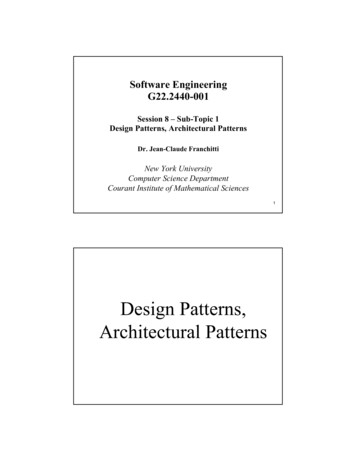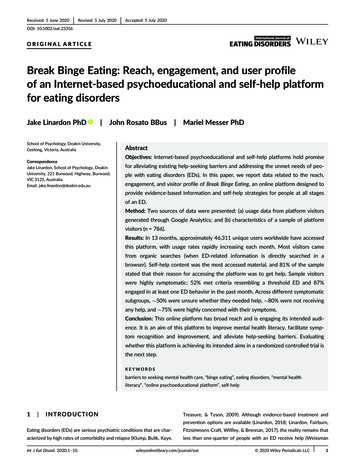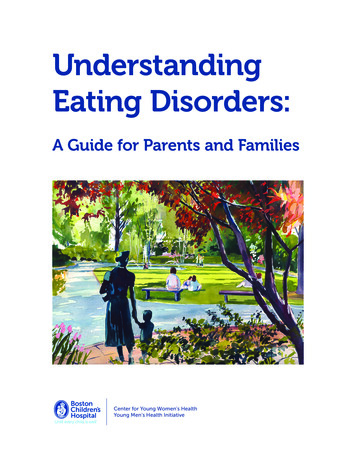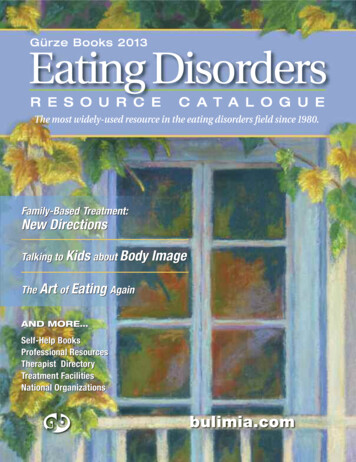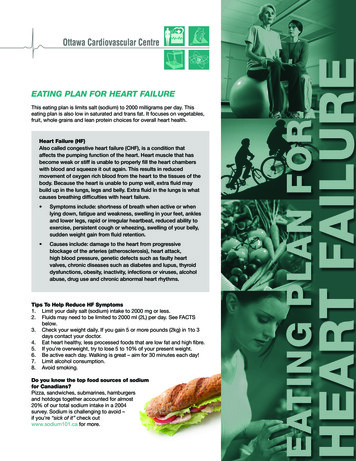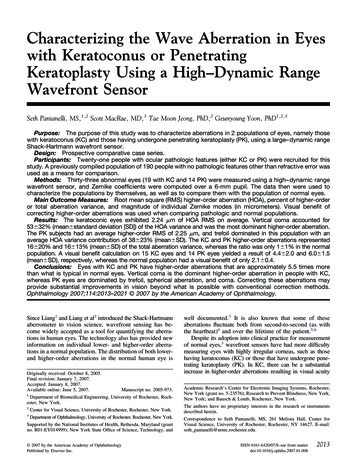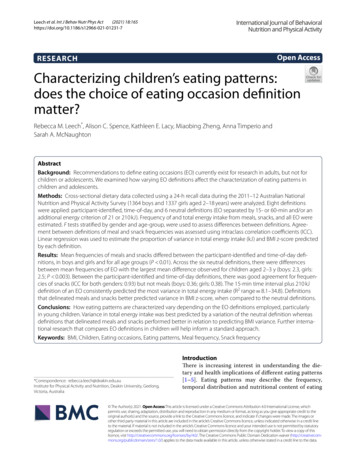
Transcription
(2021) 18:165Leech et al. Int J Behav Nutr Phys Acthttps://doi.org/10.1186/s12966-021-01231-7Open AccessRESEARCHCharacterizing children’s eating patterns:does the choice of eating occasion definitionmatter?Rebecca M. Leech*, Alison C. Spence, Kathleen E. Lacy, Miaobing Zheng, Anna Timperio andSarah A. McNaughtonAbstractBackground: Recommendations to define eating occasions (EO) currently exist for research in adults, but not forchildren or adolescents. We examined how varying EO definitions affect the characterization of eating patterns inchildren and adolescents.Methods: Cross-sectional dietary data collected using a 24-h recall data during the 2011–12 Australian NationalNutrition and Physical Activity Survey (1364 boys and 1337 girls aged 2–18 years) were analyzed. Eight definitionswere applied: participant-identified, time-of-day, and 6 neutral definitions (EO separated by 15- or 60-min and/or anadditional energy criterion of 21 or 210 kJ). Frequency of and total energy intake from meals, snacks, and all EO wereestimated. F tests stratified by gender and age-group, were used to assess differences between definitions. Agreement between definitions of meal and snack frequencies was assessed using intraclass correlation coefficients (ICC).Linear regression was used to estimate the proportion of variance in total energy intake (kJ) and BMI z-score predictedby each definition.Results: Mean frequencies of meals and snacks differed between the participant-identified and time-of-day definitions, in boys and girls and for all age groups (P 0.01). Across the six neutral definitions, there were differencesbetween mean frequencies of EO with the largest mean difference observed for children aged 2–3 y (boys: 2.3, girls:2.5; P 0.003). Between the participant-identified and time-of-day definitions, there was good agreement for frequencies of snacks (ICC for both genders: 0.93) but not meals (boys: 0.36; girls: 0.38). The 15-min time interval plus 210 kJdefinition of an EO consistently predicted the most variance in total energy intake ( R2 range 8.1–34.8). Definitionsthat delineated meals and snacks better predicted variance in BMI z-score, when compared to the neutral definitions.Conclusions: How eating patterns are characterized vary depending on the EO definitions employed, particularlyin young children. Variance in total energy intake was best predicted by a variation of the neutral definition whereasdefinitions that delineated meals and snacks performed better in relation to predicting BMI variance. Further international research that compares EO definitions in children will help inform a standard approach.Keywords: BMI, Children, Eating occasions, Eating patterns, Meal frequency, Snack frequency*Correspondence: rebecca.leech@deakin.edu.auInstitute for Physical Activity and Nutrition, Deakin University, Geelong,Victoria, AustraliaIntroductionThere is increasing interest in understanding the dietary and health implications of different eating patterns[1–5]. Eating patterns may describe the frequency,temporal distribution and nutritional content of eating The Author(s) 2021. Open Access This article is licensed under a Creative Commons Attribution 4.0 International License, whichpermits use, sharing, adaptation, distribution and reproduction in any medium or format, as long as you give appropriate credit to theoriginal author(s) and the source, provide a link to the Creative Commons licence, and indicate if changes were made. The images orother third party material in this article are included in the article’s Creative Commons licence, unless indicated otherwise in a credit lineto the material. If material is not included in the article’s Creative Commons licence and your intended use is not permitted by statutoryregulation or exceeds the permitted use, you will need to obtain permission directly from the copyright holder. To view a copy of thislicence, visit http://creativecommons.org/licenses/by/4.0/. The Creative Commons Public Domain Dedication waiver ) applies to the data made available in this article, unless otherwise stated in a credit line to the data.
Leech et al. Int J Behav Nutr Phys Act(2021) 18:165occasions (EO) [1]. EO include meals and snacks andrepresent opportunities for translating the dietary recommendations and aligning dietary intakes with thecurrent dietary guidelines. As such, EO are the fundamental intermediary steps for achieving a diet that promotes optimal health and wellbeing [6].Dietary habits tend to track over the life course andeating patterns during childhood are likely to be important for short and long-term health [7–9]. For example,frequency of shared/family meals are linked to betterdiet quality in boys and girls [10]. On the other hand,snack frequency is associated with higher intakes ofdiscretionary (i.e., energy-dense and nutrient poor)food and beverages [11–14] which may promote dental caries and obesity [9]. Evidence from cross-sectionalstudies suggest that skipping breakfast and EO frequency are positively [15, 16] and negatively [5] associated with children’s adiposity markers (e.g., BMI),respectively. However, not all cross-sectional studieshave found an association and longitudinal evidence tosupport a relationship between eating patterns and adiposity is lacking [3, 6]. Further, a key criticism of eatingpatterns research, exemplified in the breakfast skippingand EO frequency literature, is the variation acrossstudies in how EO are defined. These inconsistencieshave hampered study comparisons of children’s eatingpatterns [3, 6] and highlight the need for a standardiseddefinition of an EO [1].Whilst there is now an evidence-based recommendation for defining EO in studies of adults [2, 3], the choiceof EO definition in children or adolescent study populations has received little attention, despite a variety of definitions being used to date [14, 17–20]. Some studies haveclassified EO into meals and snacks based on participantidentification of the EO type or the time-of-day [14, 17].Other studies have employed a neutral approach wherebymeals and snack labels were not assigned to specific EO.Instead, EO are delineated using criteria based on timeand/or energy content [17–20]. How EO are definedhas been shown to affect how eating patterns are quantitatively characterised (e.g., total frequency of meals,snacks and EO) [21]. However the recommended definition for use in adults [2, 21] that applies a 15-min interval and minimum energy content of 210 kJ to delineateindividual EO may not be suitable for younger childrenwith differing appetite and satiety determinants and needto eat smaller amounts more frequently [22]. Finally, ageappropriate definitions should also consider how mealsand snacks are classified (e.g., time-of-day vs participantidentified) as adherence to conventional mealtimes [22]and the distribution of dietary intake across the mainmeals of the day may change with increasing age andindependence [7, 23, 24].Page 2 of 13Although researchers can choose from multiple definitions to characterize children’s eating patterns, there is adearth of evidence to guide which definition to use thatare age appropriate. Standardized approaches to definingEO and classifying EO types will facilitate understandingof associations between eating patterns, dietary intake,and health outcomes, and the implications of varyingdefinitions. Therefore, the aim of this study was to understand how different EO definitions affect the characterization of eating patterns among Australian children andadolescents. We also examined variance in total energyintake, weight of food intake and BMI-for-age z-scorespredicted by the frequencies of EO, meals and snacks, foreach definition.MethodsSample and study designThe study was a cross-sectional secondary analysis ofdata from the 2011–2012 National Nutrition and PhysicalActivity Survey (NNPAS). The nation-wide survey, conducted by the Australian Bureau of Statistics (ABS) fromMay 2011 to June 2012, employed a multistage, stratifiedarea, probability sampling design to recruit participantsfrom private households. The methodology of the survey has been described in detail previously [25]. Privatehouseholds in urban and rural areas of Australia were eligible for inclusion in the survey. Non-private households(e.g., hostels, boarding houses, nursing homes), households in very remote areas of Australia and those whichcontained members of non-Australian defence forces(stationed in Australia), or diplomatic personnel of overseas governments were excluded from the survey [25].For each responding household, one adult (a usual household resident aged 18 years and older), and where applicable, one child aged 2–17 years, were randomly sampled.The final sample included 9519 responding households(77% household response rate) from which 9435 participants aged 18 years and over and 2718 participants2–17 years were selected, respectively. For this study,data on 2812 children and adolescents aged 2 to 18 yearswere used (Additional File 1). During a household interview, information was collected on participants’ dietaryintakes, and sociodemographic and health characteristics. Ethics approval was provided by The Census andStatistics Act 1905 and allows the ABS to conduct allhousehold interview and measurement components ofAustralian surveys [25].Dietary assessmentInformation on child and adolescent diets were collected during an in-person 24-h recall interview whichemployed the validated US Department of Agricultureautomated multiple-pass method [26, 27]. The dietary
Leech et al. Int J Behav Nutr Phys Act(2021) 18:165recall interviews were conducted by trained ABS staff,occurred on days that suited participants and coveredall days of the week and all months of the year. The person reporting the dietary recall varied by age group. Forchildren aged 2–11 years, an adult proxy was used for theinterview; however, children aged 6–8 years were encouraged to assist in answering the questions. Interviews forchildren aged 9–11 years were proxy-assisted whereaschildren aged 12–14 were interviewed directly with aproxy in the room. For adolescents aged 15–17 years,permission was sought from their parent/guardian toconduct the dietary recall without the assistance of aproxy. A second dietary recall was conducted during atelephone interview approximately 9 days later but onlyincluded a subset (60%) of the sample [25]. A food modelbooklet containing a ruler guide and photographs/drawings of foods and food containers was used by the interviewers to help participants and/or proxies with portionsize estimation. All food and beverages reported at eachEO were uniquely coded and the Australian Supplementand Nutrient Database (AUSNUT) 2011–2013 was usedto estimate energy intakes (kJ) and total amount of foodintakes (g), and to group items as beverages or non-beverages for different eating patterns [28]. For the currentanalysis, data from the first recall was used to preservethe large and nationally-representativeness sample acrossmultiple age groups. However, to examine the robustness of findings, data from the second recall was alsoexamined.Page 3 of 13Eating occasions and their definitionsDuring the dietary recall, participants and/or proxiesrecalled the starting clock time and selected the type ofeach EO (response options included: breakfast; brunch;lunch; dinner; supper; snack; morning tea; afternoontea; drink/beverage; extended consumption; other/don’tknow) that took place in the previous 24 h. Detail ofthe foods and beverages reported at each EO, includingthe amount that was consumed, was provided. Table 1describes the eight definitions that were applied to determine EO. These were based on previously publisheddefinitions used in studies of children or adolescents [14,17–20]. Two of the definitions classified EO into mealsand snacks based on participant-identification of theEO type or the time-of-day [14, 17]. The remaining sixdefinitions used a neutral approach whereby meals andsnack labels were not assigned to specific EO. Instead,these neutral definitions identified individual EO usingtime and energy-based criteria (i.e., neutral definitions)[17–20].Classification of meals and snacksThe participant-identified and time-of-day definitionswere applied to classify meals and snacks, respectively(Table 1). Before applying these definitions, snacks andmeals of the same type (i.e., as reported by participants)occurring 15 min of each other, respectively, werecombined, consistent with previous studies [18, 21]. Forexample, two snacks reported at 10:00 am and 10:10 amTable 1 A summary of the eight definitions that were applied to determine eating occasions from dietary data collected in the NNPAS2011–12Definition appliedDescriptionMeals and snacks1) Participant-identifiedMeal: Eating occasions reported by respondents as breakfast, brunch, lunch, dinner, and supperSnack: Eating occasions reported by respondents as snack, morning/afternoon tea and beveragebreak.2) Time-of-dayMeal: Largest eating occasion (kJ) occurring between 05:30–9:30; 11:30–14:30 & 17:00–21:30 hSnack: All other eating occasionsNeutral eating occasions3) 15-min time intervalAn individual eating occasion is separated in time from the preceding and succeeding EO by 15 min.4) 15-min time interval plus 21 kJ energy criterionAn individual eating occasion contains a minimum energy content of 21 kJ (5 kcal) and is separatedin time from the preceding and succeeding eating occasions by 15 min.5) 15-min time interval plus 210 kJ energy criterion An individual eating occasion contains a minimum energy content of 210 kJ (50 kcal) and is separated in time from the preceding and succeeding eating occasions by 15 min.6) 60-min time intervalAn individual eating occasion is separated in time from the preceding and succeeding eating occasions by 60 min.7) 60-min time interval plus 21 kJ energy criterionAn individual eating occasion contains a minimum energy content of 21 kJ (5 kcal) and is separatedin time from the preceding and succeeding eating occasions by 60 min.8) 60-min time interval plus 210 kJ energy criterion An individual eating occasions contains a minimum energy content of 210 kJ (50 kcal) and is separated in time from the preceding and succeeding eating occasions by 60 min.Abbreviations: NNPAS National Nutrition and Physical Activity Survey
Leech et al. Int J Behav Nutr Phys Act(2021) 18:165Page 4 of 13would become one snack EO, commencing at 10:00 am,and two lunches reported at 12:15 pm and 12:30 pmwould become one lunch EO commencing at 12:15 pm.EO that participants identified as breakfast, brunch,lunch, dinner, or supper were considered meals. Snacksincluded EO identified as snack, morning tea, afternoontea or beverage break. Morning tea and afternoon tea aregenerally considered snack occasions in Australia andNew Zealand (originating from the UK, these EO labelstraditionally involved drinking tea with small amountsof food). For the participant-identified definition, EOidentified by participants from the response options as“extended consumption” or “other/don’t know” wereconsidered meals or snacks if they occurred at the sametime or within 15 min of an EO identified by the participant as a meal or snack (e.g. interpreted as a continuationof the preceding EO) [21]. All remaining extended consumption occasions (n 1009 EO) were then coded assnacks as this response option was included by the ABSto capture occasions where eating/drinking was spreadover time (i.e. grazing) [25]. For the time-of-day definition, meals (breakfast/brunch, lunch, and dinner/supper)were defined as the largest EO (in terms of kJ) occurring between hours of the day where the largest peaksof energy consumption have previously been reportedin Australian children and adolescents [14]. All othersmaller occasions and EO outside of these hours wereconsidered snacks (Table 1).the mean total energy intake (kJ) per EO (total energyintake from all EO divided by total frequency of EO) werecalculated. The mean total frequency of beverage-onlyoccasions and the mean total energy intake (kJ) from allbeverage-only occasions were also calculated for eachneutral definition. Finally, participants’ daily total energyintake (kJ) and total weight (g) of food and beverageintake were calculated.Identification of individual eating occasionsAnalytic sampleSix ‘neutral’ definitions were applied to delineate individual EO (Table 1). These definitions did not rely onparticipant-identification of a meal/snack or the time ofday. They varied according to the time separating preceding and succeeding EO (15 [18] or 60 min [19]) and theminimum allowable energy content of the EO (0 kJ/0 kcal[20], 21 kJ/5 kcal [17] or 210 kJ/50 kcal [18]). For example, the 15-min time interval definition would combineall reported EO occurring 15 min (including water onlyEO). Following this, the 15-min time interval plus a 21 kJ(5 kcal) energy content definition would then disregardany remaining EO that contained less than 21 kJ (5 kcal)of energy.Children and adolescents aged 2 to 18 years with data forthe first 24-h dietary recall, who were not pregnant orbreastfeeding (n 2 excluded) and who did not undertake shift work (e.g., night or rotating work shifts thatmay lead to altered eating patterns) in the past 4 weeks(n 78 adolescents aged 15–18 years excluded) were eligible for inclusion in the present study (n 2732 eligible; Additional File 1). Participants were excluded fromthe analysis (n 31 excluded) if: time of eating was notreported, reported daily energy intake ( 210 kJ) wasimplausible or if they reported an EO as “other/don’tknow” (i.e., EO that could not be categorised as a mealor snack). After all exclusions (n 111), the final analyticsample included 1364 boys and 1337 girls of whom 1124(82%) and 1082 (81%) had available data for height andweight, respectively (Additional File 1).Eating pattern and dietary intake variablesThe mean total frequency of meals and snacks, the meantotal energy intake (kJ) from meals and snacks, and themean total energy intake per meal and snack (e.g., totalenergy intake from all meals and snacks divided by totalfrequency of meals and snacks, respectively) were calculated using the participant-identified and time-of-daydefinitions. For all six neutral definitions, the mean totaleating frequency, the mean time between EO (min), andAnthropometricsHeight (cm) was measured to 1 decimal point using aportable stadiometer and weight (kg) was taken usingdigital scales. BMI-for-age z-scores were calculated inStata 15.0 (Stata Inc., College Station, TX, USA; zanthropackage) by applying the World Health Organizationgrowth reference standards [28].Sociodemographic characteristicsFor the present analysis, age (y) was categorised intothe following age-groups in alignment with dietary recommendations [29]: 2–3 y; 4–8 y; 9–11 y, 12–14 y and15-18y, and each participant’s country of birth was categorised by the ABS as Australia, other ‘mainly Englishspeaking’ countries or all other countries. Area-leveldisadvantage was determined using the ABS’s SocioEconomic for Areas (SEIFA) Index of Relative SocioEconomic Disadvantage quintiles which ranged from one(most disadvantaged) to five (most advantaged).Statistical analysisPerson-specific weights, adjusted for probability of selection and non-response, were used to provide estimatesrelating to the whole population and replicate weights(jack-knife delete 1 method) were used to account forthe clustered survey design. All analyses were conducted
Leech et al. Int J Behav Nutr Phys Act(2021) 18:165in Stata 15 and were stratified by gender and age-group.Descriptive statistics for sociodemographic and eating patterns are presented as weighted proportions orweighted means (standard deviation). The F test (TESTcommand) with Bonferroni correction was used todetermine differences between the different EO definitions. Alpha was conservatively set at 0.01 for comparisons between the participant-identified and time-of-daydefinition and at 0.003 for multiple comparisons betweenthe six neutral definitions (0.05/15 comparisons). Mixedeffect models were used to estimate intra-class correlation coefficients (ICC) for the absolute agreement of thefrequency of meal and snack EO between the participantidentified and time-of-day definitions. Separate multiple linear regression models were used to determine theproportion of variance (model adjusted R-square value)in total energy intake (kJ), total amount of food/beverageintake (g) and BMI z-score (all continuous variables) predicted by the total meal and snack frequencies (both variables entered as separate predictors in the same model)and total EO frequency, calculated for each definition.The total energy intake and amount of food/beverageintake variables were positively skewed and therefore logtransformed prior to the regression analysis. The regression analysis with BMI z-score as the outcome included acrude model and a model additionally adjusted for totalenergy intake. To check the robustness of eating patternsdetermined using one dietary recall, all data managementprocedures and analyses were repeated using data fromthe second dietary recall that was completed by 822 boysand 792 girls, of whom 717 and 673 had available dataon BMI, respectively. Due to the smaller number of participants who completed the second recall day, sensitivity analyses were stratified by gender and following agegroups: 12 years and 12 years and over.ResultsTable 2 presents the sociodemographic characteristics ofboy and girl participants from the NNPAS. There were nodifferences in proportions of boys and girls representedby age group, country of birth or area-level disadvantage.However, gender differences in total energy intake (kJ)and weight of food and beverage intake were observed forchildren aged 4–8 and 15–18 years. Total energy intake,but not weight of food and beverage intake, was also different between boys and girls aged 12–14 y (p 0.01).There were no statistically significant gender differencesin BMI-for-age z-scores.Characterisation of meals and snacksWhen comparing the participant-identified and timeof-day definitions, differences were found for EO frequency of meals and snacks separately, but not for totalPage 5 of 13EO, across all age-groups (Table 3). However, fewerdifferences were found for the total energy intake fromeither meals or snacks in boys (4–8 y, 9–11 y and 15–18y only) and girls (12–14 y and 15–18 y only) betweendefinitions. Regarding total energy intake per meal,differences were observed among boys aged 4–8 y and9-11y and girls aged 2–3 y and 4–8 y. There were no differences in energy intake per snack when applying theparticipant-identified definition versus the time-of-daydefinition (Table 3).There was very good agreement (Intra-class Correlation coefficient [95% confidence interval]) in the frequency of snacks (boys: 0.93 [0.91, 0.94], girls: 0.93 [0.90,0.94) between the participant-identified and time-ofday definitions. Results were similar after stratificationby age group (boys: ICC range 0.90–0.94; girls: ICCrange 0.89–0.94). However, poorer agreement betweendefinitions was observed for the frequency of meals(boys: 0.36 [0.29, 0.43], girls: 0.38 [0.30, 0.46]). Afterstratification by age-group, ICCs ranged from 0.14–0.42for boys and 0.13–0.51 for girls, with the lowest agreement observed for boys aged 4–8 y and girls aged 9–11 y(data not shown).Characterisation of eating occasionsTable 4 presents the total EO frequency, mean timebetween EOs, total energy intake per EO, total frequencyof beverage-only occasions and total energy intake frombeverage-only occasions for the six variations of the neutral definition. In general, frequency of EO (includingbeverage-only occasions) decreased and energy intakeper EO increased concomitant with applying longer timeintervals (15 to 60 min) to delineate individual EO. However, the decreases in EO frequency and increases in timebetween EO after applying a higher minimum energy criterion (21 to 210 kJ) were generally greater for the 15-mintime interval than the 60-min time interval definition.Fewer differences between definitions were observed forfrequency of beverage-only occasions and total energyintake from beverage-only occasions. Applying a 21 kJ or210 kJ energy criterion to the 15-min time interval definition significantly reduced the frequency of beverageonly EO but had little impact on total energy intake frombeverage-only occasions, when compared to no energycriterion. Few differences in frequency of beverageonly occasions and no differences in energy intake frombeverage-only occasions were observed after applyingeach energy criterion within the 60-min interval definition. However, there were significant differences in totalenergy intake from beverage-only occasions when comparing variations of the 15-min time interval with variations of the 60-min time interval definitions.
Leech et al. Int J Behav Nutr Phys Act(2021) 18:165Page 6 of 13Table 2 Sociodemographic characteristics of child and adolescent participants in the NNPAS 2011–12. Results are presented asweighted percentages (%) or weighted means (SD)Boys (n 1364)Girls (n 82625Australia9190Other mainly English-speaking countries54All other countries469394Quintile 11816Quintile 22018Quintile 31922Quintile 41720Quintile 525242–3 y6040 (2394)5850 (2387)4–8 y7639 (2322)6436 (2066)*9–11 y8962 (2830)8100 (2602)12–14 y9590 (3136)7832 (2813)*15–18 y10,270 (4210)8178 (3173)*2–3 y1873 (788)1679 (713)4–8 y2162 (715)1941 (605)*9–11 y2527 (801)2384 (743)12–14 y2700 (868)2500 (784)15–18 y3150 (1354)2644 (946)*2–3 y0.8 (1.3)0.8 (1.2)4–8 y0.7 (1.2)0.6 (1.2)9–11 y1.1 (1.2)0.7 (1.0)12–14 y0.6 (1.1)0.8 (1.0)15–18 y0.5 (1.1)0.3 (1.0)Age group (years), %Country of Birth, %Mainly speaks English at home, %Area-level disadvantage (SEIFA)1 quintiles. %Total energy intake (kJ), mean (SD)Total weight of food and beverage intake (g), mean (SD)BMI-for-age z-scores, mean (SD)Abbreviations: BMI body mass index; NNPAS National Nutrition and Physical Activity Survey1Australian Bureau of Statistics Socio-Economic Indexes for Areas. SEIFA quintiles range from one (most disadvantaged) to five (most advantaged)*P 0.01; F test of significant difference between boys and girls with Bonferroni adjustmentProportion of variance in total energy intake, total weightof food and beverage intake and BMI‑for‑age z‑scoresexplained by the eating occasion definitionsAmong both genders and across all age groups, thehighest proportion of variance in total energy intakewas predicted by the 15-min plus minimum 210 kJ neutral definition (range 8.1–34.8; Table 5). No consistentfinding was observed for total weight of food/beverageintake. The highest R-squared values were observedfor the participant-identified definition among boysaged 15–18 y (16.2%) and for the time-of-day definition among girls aged 12–14 y (16.5%). The participantidentified definition best predicted variance in amountof food intake among boys and girls aged 15–18 years,whereas the time-of-day approach best predicted variance in amount of food intake among boys and girlsaged 4–8 y, boys aged 9–11 y and girls aged 12–14 y.Table 6 presents the proportion of variance of BMI
Leech et al. Int J Behav Nutr Phys Act(2021) 18:165Page 7 of 13Table 3 Total frequency of meals and snacks, total energy intake from meals and snacks, and total energy intake per meal and persnack for the participant-identified versus time-of-day definitions: results from 2011 to 12 NNPAS by gender and age g Participant-identifiedTime-of-dayFrequency of meals2–3 y2263.0 (0.7)2.8 (0.4)*2343.2 (0.8)2.9 (0.4)*4–8 y3933.1 (0.5)2.9 (0.3)*3863.1 (0.5)2.9 (0.3)*9–11 y2233.1 (0.6)2.9 (0.3)*2293.1 (0.5)2.9 (0.3)*12–14 y1593.0 (0.5)2.8 (0.3)*1662.8 (0.7)2.6 (0.5)*15–18 y3632.7 (0.7)2.6 (0.6)*3222.9 (0.6)2.6 (0.6)*Frequency of snacks2–3 y2263.8 (2.0)4.0 (2.0)*2343.8 (2.2)4.2 (2.3)*4–8 y3933.4 (1.6)3.6 (1.7)*3863.4 (1.4)3.5 (1.5)*9–11 y2233.4 (1.4)3.6 (1.5)*2293.4 (1.3)3.6 (1.2)*12–14 y1593.1 (1.5)3.3 (1.4)*1663.3 (1.5)3.5 (1.4)*15–18 y3633.0 (1.6)3.1 (1.6)*3222.7 (1.5)3.0 (1.6)*Total energy intake from meals (kJ)2–3 y2264063 (2017)3972 (1882)2343748 (1815)3707 (1743)4–8 y3935251 (1868)5090 (1819)*3864331 (1663)4314 (1650)9–11 y2236069 (2151)5836 (1968)*2295480 (2309)5329 (2070)12–14 y1596880 (2558)6545 (2541)1665150 (2020)4891 (1986)*15–18 y3637252 (3380)6822 (3181)*3225942 (2690)5559 (2754)*Total energy intake from snacks (kJ)2–3 y2261976 (1301)2067 (1517)2342102 (1866)2143 (1562)4–8 y3932387 (1514)2549 (1521)*3862104 (1339)2122 (1241)9–11 y2232893 (1859)3126 (1856)*2292620 (1627)2771 (1399)12–14 y1592710 (2044)3046 (2101)1662682 (1936)2942 (1828)*15–18 y3633018 (2577)3448 (2933)*3222236 (1799)2619 (1874)*Energy intake per meal (kJ)22–3 y2261372 (631)1399 (630)2341188 (541)1287 (567)*4–8 y3931683 (574)1741 (627)*3861413 (531)1471 (548)*9–11 y2231976 (748)2081 (818)*2291790 (669)1847 (706)12–14 y1592377 (904)2359 (890)1661849 (657)1878 (684)15–18 y3632673 (1148)2689 (1267)3212115 (967)2177 (1048)Energy intake per snack (kJ)32–3 y225547 (400)542 (591)231548 (397)538 (386)4–8 y387753 (484)758 (592)381675 (526)647 (394)9–11 y220899 (554)908 (497)225802 (501)832 (455)12–14 y153919 (722)953 (463)162865 (587)867 (509)15–18 y3511110 (1384)1111 (976)308924 (776)934 (659)Abbreviations: NNPAS National Nutrition and Physical Activity Survey1Values are all weighted means (SD). Total eating occasion frequency can be calculated for each definition by summing the frequency of meals and frequency ofsnacks23*n 1 girl aged 15–18 y did not self-report eating any mealsSelf-reported snack consumers include n 1336 boys and n 1307 girlsP 0.01; F test of signific
occasions (EO) []. EO include meals and snacks and 1 represent opportunities for translating the dietary rec-ommendations and aligning dietary intakes with the current dietary guidelines. As such, EO are the funda-mental intermediary steps for achieving a diet



